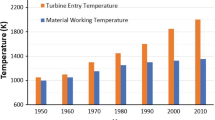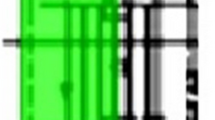Abstract
For the aero engine, size and weight of the combustors are important considerations along with long operating life and its overload capability. The combustor which is considered for this research has an annular shape with a thickness of 2 mm. The combustor casing is manufactured out of forging by machining to a thickness of 2 mm. This method has the advantage of better control of the thickness so that the desired thickness can be maintained throughout the component. Structural analysis has been carried out for the overload condition which is taken as twice the maximum operating pressure and at engine operating temperature analytically. The strength of the combustor casing has been evaluated analytically before subjecting it to experimental test. It is a mandatory requirement from the airworthiness point of view to evaluate its overload capability and to validate the manufacturing methodology by means of full scale rig tests before it is declared fit to fly. Details of the test facility, test adaptors, adaptation of the combustor to the test facility, instrumentation and the testing are presented in this paper. The component is inspected before starting the test and at the end of the test. No cracks and no change in dimensions are observed as per the inspection reports. The combustor casing has withstood the proof pressure test and demonstrated its overload capability for its safe life. The manufacturing process, that is, manufacturing of the combustor out of forging is also validated by means of this test.
Similar content being viewed by others
References
Koff, B.L., “Gas Turbine Technology Evolution: A Designer’s Perspective,” Journal of Propulsion and Power 20(4): 577–589 (2004).
MIL-E-5007D, Military specifications, General specifications for Engines, aircraft, turbojet and turbofan, United States of America, 15, October 1973.
Shakariyants, S.A., Van Buijtenen, J.P., Visser W.P.J., (2004) “Generic Geometry Definition of the Aircraft Engine Combustion Chamber,” GT2004-53522, Proceedings of ASME Turbo Expo 2004, Vienna.
Pegemanyfar, N., Pfitzner, M., (2006) “Development of a Combustion Chamber Design Methodology and Automation of the Design Process,” 25th International Congress of the Aeronautical Sciences, ICAS 2006.
Jin, Y., Xiaomin, H.E., Jiang, B., Zejun, W.U., and Guoyu, D., “Design and Performance of an Improved Trapped Vortex Combustor,” Chinese Journal of Aeronautics 25(6): 864–870 (2012).
Huda, Z., and Edi, P., “Materials Selection in Design of Structures and Engines of Supersonic Aircrafts: A Review,” Materials & Design 46: 552–560 (2013).
Thomas, A., El-Wahabi, M., Cabrera, J.M., and Prado, J.M., “High Temperature Deformation of Inconel 718,” Journal of Materials Processing Technology 177(1-3): 469–471 (2006).
Muller, U., Hoschler, K., Gerendas, M., Bauer, H.J., and Schoth, U., “Mechanical Analysis of an Aero-engine Combustor under Operation Conditions using a Unified Constitutive Material Model for Deformation Simulation,” European Structural Integrity Society 29: 351–360 (2002).
Dawicke, D.S., Poe, C.C., Newman, J.C., and Harris, C.E., “An Evaluation of the Pressure Proof Test Concept for Thin Sheet 2024-T3,” Journal of Theoretical and Applied Fracture Mechanics 14(2): 101–116 (1990).
INCONEL ALLOY 718, INCO Alloys International Material Broacher, 4th Edition, Inco Alloys International Inc., Huntington, West Virginia, 25720, USA (1985).
ASTM Standard E-8. Standard test methods for tension testing of metallic materials, United States of America (2008).
Petley, V. GTRE Internal Report No. GTRE/SIMA/MG/MTL/10/02-001, India, Feb-2010.
Savas, T.P., “Fatigue and Stress Analysis of a Novel Test Coupon Geometry Developed for Hydraulic Pressure Impulse Testing,” Journal of Testing and Evaluation 28(5): 8 (2000).
Bush, R.W., “Effect of Dither on Strain-Controlled Fatigue and Tensile Results Obtained with a Closed-Loop Servo hydraulic Testing Machine,” Journal of Testing and Evaluation 13(6): 13–16 (1985).
Hooper, M.N., Hutchinson, A.R., Broughton, J.G., and Taylor, M.A., “Development of a Novel Test Rig for the Evaluation of Aircraft Fuel Tank Sealant,” Journal of Testing and Evaluation 40(1): 177–183 (2012).
Nonaka, I., Ito, T., Takemasa, F., Saitou, K., Miyachi, Y., and Fujita, A., “Full Size Internal Pressure Creep Test for Welded P91 Hot Reheat Elbow,” International Journal of Pressure Vessels and Piping 84(1-2): 97–103 (2007).
Hooreweder, V.B., Moens, D., Boonen, R., and Sas, P., “Design and Simulation of a Novel Multiaxial Fatigue Test Rig,” International Journal of Experimental Mechanics 52(5): 513–524 (2012).
Yun, G.J., Abdullah, A.B.M., and Binienda, W., “Development of a Closed Loop High Cycle Resonant Fatigue Testing System,” International Journal of Experimental Mechanics 52: 275–288 (2012).
Pach, E., Korin, I., and Ipina, J.P., “Simple Fatigue Testing Machine for Fibre- Reinforced Polymer Composite,” Experimental Techniques 36: 76–82 (2012).
Munoz, V., Rohr, G.A., Cavalieri, A.L., and Tomba, M., “Experimental Procedure for the Mechanical Evaluation of Oxide-Carbon Refractories by Strain Measurement,” Journal of Testing and Evaluation 40: 194–201 (2012).
Okayasu, M., and Sato, Y., “New Experimental Techniques for In-Situ Measurement of the Damage Characteristics of Piezoelectric Ceramics under High Cycle Fatigue Testing,” International Journal of Experimental Mechanics 52: 1009–1020 (2012).
Acknowledgments
The authors express their gratitude to the Director, Gas Turbine Research Establishment, Bangalore for permitting to publish this work. Also the authors would like to convey their special thanks to Shri P. Ramesh of Structural Integrity Group, Ms Srisanthi Potluri andMs. Sangeeta Baxla of Structural Mechanics Group for their cooperation in making various technical data available to prepare this report.
Author information
Authors and Affiliations
Corresponding author
Rights and permissions
About this article
Cite this article
Panigrahi, S.K., Sarangi, N. & Chandrasekhar, U. Experimental Evaluation of Overload Capability of an Annular Combustor Casing of a Gas Turbine Engine. Exp Tech 40, 841–848 (2016). https://doi.org/10.1007/s40799-016-0083-z
Published:
Issue Date:
DOI: https://doi.org/10.1007/s40799-016-0083-z




